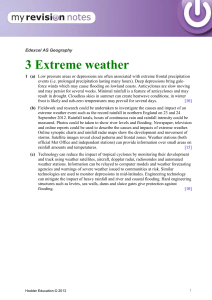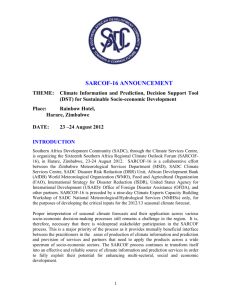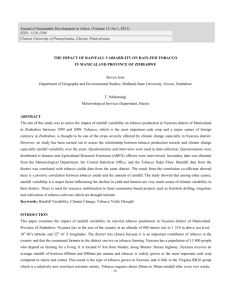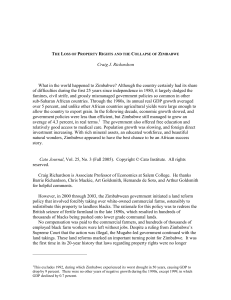Understanding water use patterns in urban centres of
advertisement
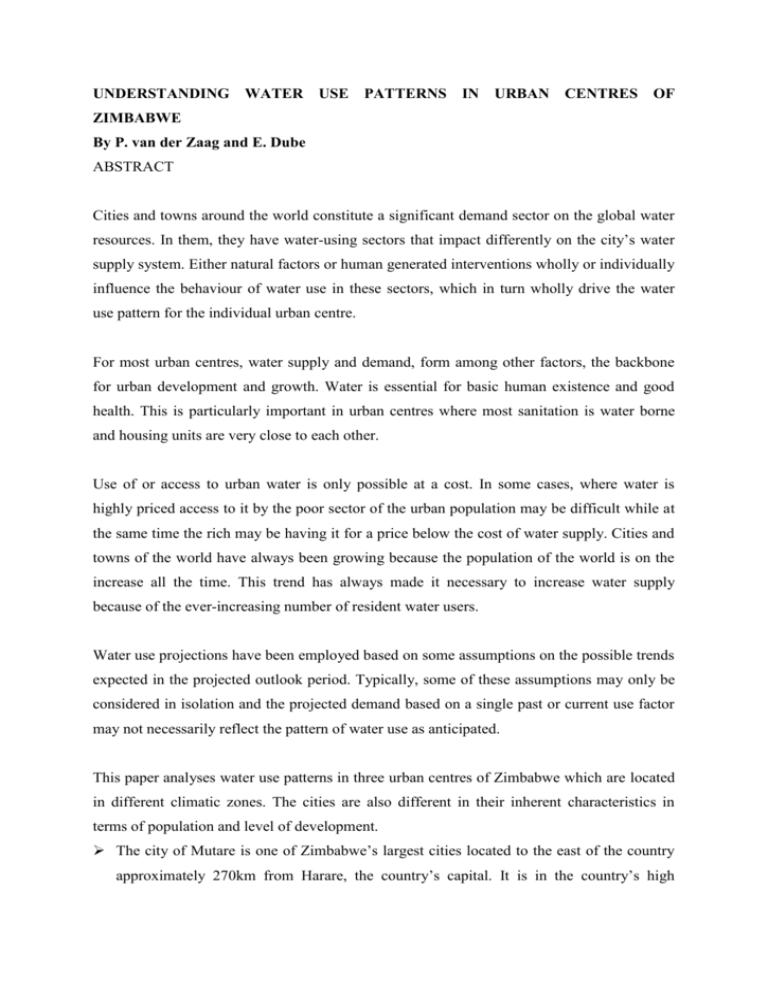
UNDERSTANDING WATER USE PATTERNS IN URBAN CENTRES OF ZIMBABWE By P. van der Zaag and E. Dube ABSTRACT Cities and towns around the world constitute a significant demand sector on the global water resources. In them, they have water-using sectors that impact differently on the city’s water supply system. Either natural factors or human generated interventions wholly or individually influence the behaviour of water use in these sectors, which in turn wholly drive the water use pattern for the individual urban centre. For most urban centres, water supply and demand, form among other factors, the backbone for urban development and growth. Water is essential for basic human existence and good health. This is particularly important in urban centres where most sanitation is water borne and housing units are very close to each other. Use of or access to urban water is only possible at a cost. In some cases, where water is highly priced access to it by the poor sector of the urban population may be difficult while at the same time the rich may be having it for a price below the cost of water supply. Cities and towns of the world have always been growing because the population of the world is on the increase all the time. This trend has always made it necessary to increase water supply because of the ever-increasing number of resident water users. Water use projections have been employed based on some assumptions on the possible trends expected in the projected outlook period. Typically, some of these assumptions may only be considered in isolation and the projected demand based on a single past or current use factor may not necessarily reflect the pattern of water use as anticipated. This paper analyses water use patterns in three urban centres of Zimbabwe which are located in different climatic zones. The cities are also different in their inherent characteristics in terms of population and level of development. The city of Mutare is one of Zimbabwe’s largest cities located to the east of the country approximately 270km from Harare, the country’s capital. It is in the country’s high rainfall area, average annual rainfall above 1500mm and has an urban population of over 120,000 people The city of Masvingo is located to the south of Zimbabwe and is about 300km from Capital City. It is in a drought prone region of average annual rainfall of 600mm.The urban population is about 70,000 people. The town of Ruwa is less than 30km from Harare city centre. It is like a dormitory town for the city as most of its residents are employed in the city. It therefore has climatic characteristic similar to those of Harare. UNDERSTANDING PAST WATER USE In water use studies carried out in the three urban centres population, rainfall, gross domestic product and rationing were found to have a significant impact on water use. The combined effect of these factors was analysed using multiple linear regression analysis and it was found that water use in urban areas can be explained by a formula of the form: Q=a+b*N+c*P+d*G+e*R Where Q = annual treated water pumped (1,000 m3/a) N = population (1,000) P = annual precipitation (mm/a) G = GDP growth (%) R = factor for rationing, with a memory specifically chosen depending on the severity; where 1 is taken as the year when it was most severe reducing yearly to 0. a, b, c, d, and e are constants that come off the regression analysis The usefulness of this formula is dependant on the availability of continuous water use data over a long period of say 20 years. It has been shown, in the Masvingo water use study, that the correlation coefficient was 0.965 for data from 1977 to 2001. The applicable formula for the city of Masvingo was Q = 1,496 + 90.2 *N – 1.5 P + 26.8 * G –837 * R Which can be interpreted thus: Population has a positive impact on water use and so also is positive GDP.These will increase the quantity of water to be supplied. If rainfall were above average annual figures water use would decrease and conversely if it were below the annual average water use would increase. Water rationing reduces water consumption and hence this factor is negative The formula for Mutare was and that for Ruwa was FUTURE WATER USE PROJECTIONS The factors of population, rainfall, and GDP, can be projected into the future for reasonably short outlook periods of up to 10 years with some acceptable level of confidence. Because of this, a multiple linear regression analysis can be applied to determine future water demand for the conventional water demand in urban centres drawing from past consumption patterns. PATTERNS OF WATER USE IN DIFFERENT DOMESTIC NEIGHBOURHOODS In the Masvingo study, plot sizes, level of affluence/poverty and rainfall had an influence on the pattern of water use in the domestic sector in different neighbourhoods. It was found that these factors influenced water use in the high-income, low-density, areas more than in the low-income, high-density, areas. Whereas water use increased in the dry months of the year in the low-density areas, water use in the high- density areas was less sensitive to rainfall.







